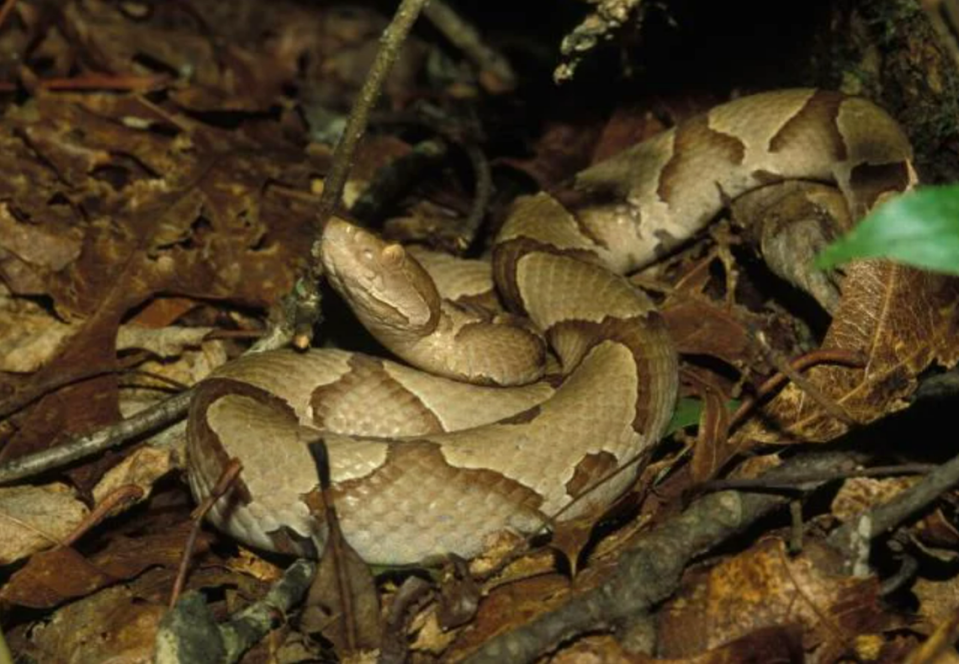If a copperhead snake bites your dog in SC, follow these tips to save the pup
If a slithery copperhead bites your four-legged friend out on a walk, what should you do?
Now deep into summer, many dog owners will take their pets out on adventures, hikes or to play in state parks. But as the warmer temperatures entice dogs to play outside, they also encourage more snakes to show their scaly heads, creating potential risk.
Of the six venomous snakes in South Carolina, the copperhead is the most common. Here is information on how to identify copperheads and what veterinarians recommend pet owners should know and do if they believe their dog has been bitten.
Identifying a copperhead
The copperhead gets its name from the coppery-tan color on its head and on parts of its body, Clemson Cooperative Extension states. Copperheads have triangular-shaped heads, similar to an arrowhead and can grow up to 4 feet long. They are found in both wet and dry hardwood forests.

Copperheads also feature an hourglass-shaped pattern on their bodies — from the head down to the tail. When curled up, this camouflage can make them look like a pile of leaves. And like most other venomous snakes in South Carolina, copperheads have yellow eyes with black vertical and elliptical pupils.
Copperhead bite severity
According to the Charleston Veterinary Referral Center, the size of the pet and location of the venomous bite will determine the severity. Dogs are most commonly bitten in the face, tongue, eyes and neck. Bites in these areas are more serious since the venom is often delivered directly into the victim’s bloodstream. Also, adult snakes and juveniles may inject different amounts of venom.
What to do if your dog is bitten
Tissue swelling begins within minutes. Other tell-tale signs can be excessive drooling, foaming at the mouth and sudden tiredness.
Keep the animal as quiet as possible. Activity increases the distribution of the venom.
Seek veterinary care immediately. Appropriate veterinary care includes pain management, infection prevention, anti-inflammatory therapy, antivenin administration and management of any other concurrent problems such as open wounds or blood clotting disorders.
Several hours of veterinary observation is recommended to ensure the animal is OK after treatment of the snake bite.
Snake bite treatments to avoid
There are several “old wives tales” regarding treatment of venomous snakebites at home or in the field. These include application of ice to the bite site to constrict blood vessels and slow spread of the toxin, as well as making cuts in the skin near the bite wound to encourage the toxin to be “bled” from the body. Other myths include directly sucking on the wound to try to draw the venom out through where it entered or applying a tourniquet to the limb above the bite to contain the toxin and prevent its spread through the body.
However, research has shown that these steps do not improve outcome and rather can cause worse illness or make treatment more difficult in the long run. Instead, immediate and aggressive evaluation and treatment by a veterinarian is advised.
Safety Precautions
Most snake bites in pets are to the face, neck, and limbs, since they are sniffing around objects where snakes tend to hide. To avoid these chance encounters, keep these tips in mind.
Keep your yard tidy by clearing away undergrowth, toys, and tools that make great hiding places for snakes.
Keep walkways clear of brush, flowers and shrubs.
Clean up any spilled food, fruit or bird seed, which can attract rodents-and therefore snakes-to your yard.
When walking pets, keep them on a leash.
Steer your pet clear of long grasses, bushes, timber, and rocks which provide camouflage.
Snakes can strike across a distance equal to about half their body length. If you see a snake, head back the way you came.
Familiarize yourself with snakes who are common in your area. In the event of a bite, identifying the type of snake may help with your pet’s treatment.


